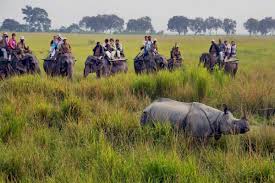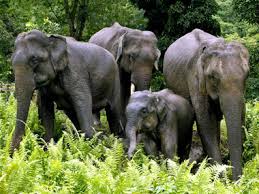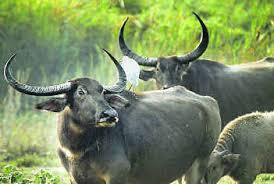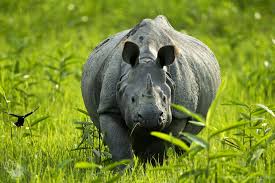|
Kaziranga National Park is the name
to exemplify the most popu lar
conservation efforts to save the endangered species like
one-horned rhinoceros in India. Located in the Golaghat and Nagaon
district of Assam, this most notable wildlife sanctuary is being
declared as a World Heritage Site by UNESCO in the year 1985. The
park resides at an edge of the Eastern Himalayan biodiversity
hotspot and this could be the perfect reason to envision high
degrees of diversified species with great visibility. lar
conservation efforts to save the endangered species like
one-horned rhinoceros in India. Located in the Golaghat and Nagaon
district of Assam, this most notable wildlife sanctuary is being
declared as a World Heritage Site by UNESCO in the year 1985. The
park resides at an edge of the Eastern Himalayan biodiversity
hotspot and this could be the perfect reason to envision high
degrees of diversified species with great visibility.
The park lies in the flood plains of Brahmaputra River and so
every year the region is completely drenched with high water
level; so do the wildlife gets affected by it too. And keeping
such messy situation in mind, the park officials are always ready
for every kind of provision for the safety of the jungle beings of
Kaziranga.
Wildlife in Park
The land of Kaziranga which is rich in one-horned rhinos and elep hants
supports the growth and survival of a unique and diverse wildlife.
Apart from being a rich natural habitat for Rhinos, Kaziranga
Sanctuary also has a sizable population of the Wild Buffalos and
great herds of wild elephants, sometimes numbering up to 200,
including other major counts of species like: hants
supports the growth and survival of a unique and diverse wildlife.
Apart from being a rich natural habitat for Rhinos, Kaziranga
Sanctuary also has a sizable population of the Wild Buffalos and
great herds of wild elephants, sometimes numbering up to 200,
including other major counts of species like:
Wildlife at Kaziranga National ParkMammals - Indian wild boar (sus
scrofa), eastern mole (talpa micrura), pangolin (manis
crassicaudata), indian gaur (bos gaurus), sambar (cervus unicolor),
barking deer (muntiacus muntjak), white browed gibbon (hylobates
hoolock), hog deer (axis porcinus), capped langur or leaf monkey (presbytis
pileatus), assamese macaque (macaca assamensis), rhesus macaque (macaca
mulatto), leopard (panthera pardus), golden jackal (canis aureus),
sloth bear (melursus ursinus), fishing cat (felis viverrina),
jungle cat (felis chaus), large indian civet (viverra zibetha),
small indian civet (viverricula indica), indian gray mongoose (herpestes
edwardsi), small Indian mongoose (herpestus auropunctatus), bengal
fox (vulpes bengalensis), common otter (lutra lutra), Chinese
ferret badger (melogale moschata), hog badger(arctonyx collaris),
ganges and Indus river dolphin (platanista gangetica),
orange-bellied Himalayan squirrel (dremomys lokriah), Asiatic
black bear, swamp deer (cervus duvauceli) and Indian porcupine (hystrix
indica).
Reptiles - Snakes, Lizards, Tortoises, Alligator (Gharial),
Crocodile
Flora in Kaziranga
Kaziranga National Park has chiefly three major typ es
of flora as alluvial inundated grasslands, tropical wet evergreen
forests and tropical semi-evergreen forests. But, the main
characteristics of flora in Kaziranga are the dense and tall
elephant grasses intermixed by small swamplands which are left
behind by the receding floodwaters of the river Brahmaputra. es
of flora as alluvial inundated grasslands, tropical wet evergreen
forests and tropical semi-evergreen forests. But, the main
characteristics of flora in Kaziranga are the dense and tall
elephant grasses intermixed by small swamplands which are left
behind by the receding floodwaters of the river Brahmaputra.
In addition to grasses and forests, Kaziranga National Park
includes abundant cover of water lilies, water hyacinth and lotus
brining a beautiful scenario to the surroundings. Rattan Cane,
which is a type of climbing palm, also adds beauty of Kaziranga
National Park. Different vegetation coverage in Kaziranga National
Park is: tall thickets of elephant grasses 41%, short grasses 11%,
open jungle 29%, rivers and water bodies 8%, sand 6% and swamps
4%.
Nearby Places of Kaziranga
Addabarie Tea Estate - established by the British Assam Tea Company in the year 1864, this is an
ultimate tea estate near the area of Tezpur. The area attracts the
people for its far-stretched green beauty and for Wild Mahseer, an
independent British aged bungalow with many attractions to reflect
the British Assam colonial lifestyle.
by the British Assam Tea Company in the year 1864, this is an
ultimate tea estate near the area of Tezpur. The area attracts the
people for its far-stretched green beauty and for Wild Mahseer, an
independent British aged bungalow with many attractions to reflect
the British Assam colonial lifestyle.
Guwahati - The capital of Assam is a flaky destination
composed of religious, industrial, wildlife and natural
bewilderments. Assam State Museum, Srimanta Sankardeva Kalakshetra
are the prominent spots to learn the cultural assets of Assam.
Besides, the famous Kamakhya Temple, dedicated to Goddess Durga
attracts many devotees around the year.
Manas National Park - Located on the bank of the river Manas
at the Himalayan foothills, the Manas National park is the most
pictorial sanctuary in the area located 176 kms away from Guwahati
and was earlier known as Kamrup Wildlife Sanctuary. It was
established as the core of the Manas Tiger Reserve from April 1973
and elevated to the position of a National Park status on
September 7, 1990. It is a well known World heritage site with its
unique combination of scenic beauty and rare wealth of wildlife.
Nameri National Park -The Nameri National Park is the most
scenic one with the presence of bifurcating river Jia Bhoroli to
cover an area of 200 sq km. Set up as a sanctuary in the year
1985, the park attained the national park designation in the year
1988 with great amounts of faunas, avi-faunas and floral sections
in the area with the abundance presence of herds of elephants.
Best Season to Visit
The best season to visit Kaziranga National Park is between
November and April. From 1st of Nov to 30th of April, the park
remains open daily for continuous six months being the monsoons as
the exceptional season to close the area for safety reasons by the
national park management.
Since, Kaziranga lies on the banks of Brahmaputra River, every
year the reserve area has to face the flooded situation on heavy
monsoons leading to great losses and the management has to take
great care and precautions to save the precious species. This is
the reason it is partially opened during the months of October and
May and is completely closed during June to September.
Safari Timings
For Jeep Safari
Jeep Safari is available from 1st November to 30th April and could
be possible subject to weather and road condition on the months of
May & October.
Morning Jeep Safari: 07: 09:30
Afternoon Jeep Safari: 13:30: 15:30 |